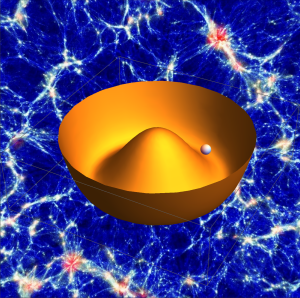[Research] Axions Could Explain the Origin of Cosmic Structure

Backgroud: Numerical simulation of the cosmic web (Copyright: Image courtesy of Klaus Dolag, Universitäts-Sternwarte München, Ludwig-Maximilians-Universität München, Germany)
Assistant Professor Takeshi Kobayashi of the Kobayashi-Maskawa Institute for the Origin of Particles and the Universe (KMI), Nagoya University, proposes that an elementary particle called the axion could have been the origin of the cosmic structure of our universe.
Astrophysical studies in the past decades have established that the cosmic structure, including galaxies and galaxy clusters, arises from tiny fluctuations in the energy density when the universe was young; however the origin of this primordial density fluctuation still remains one of the biggest mysteries of modern cosmology. The new study by Kobayashi shows that the density fluctuation could have been seeded by the axion—an undiscovered elementary particle that is currently being searched for by numerous experiments around the globe. Not only that this study provides an explanation for the origin of the cosmic structure, but it also sheds new light on the cosmological role of the axion. The proposed theory also makes predictions about how galaxies and galaxy clusters should be distributed in our universe, and hence is testable with large-scale structure surveys that will soon start operation. This research was published in Physical Review Letters on July 1, 2020.
It’s a rather simple idea, and I also like the fact that the hypothesis can soon be tested by upcoming astrophysical experiments. It was a fun project to work on! (Assistant Professor Takeshi Kobayashi)
Paper Information
Kobayashi, “Axionlike Origin of the Primordial Density Perturbation”, Phys. Rev. Lett. 125, 011302 – Published 1 July 2020
https://journals.aps.org/prl/abstract/10.1103/PhysRevLett.125.011302



